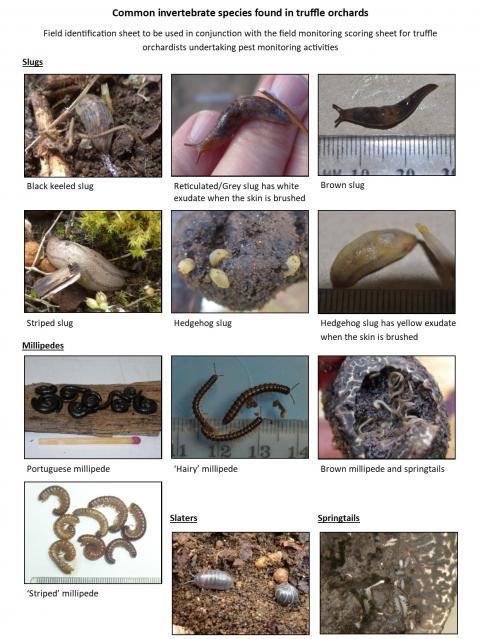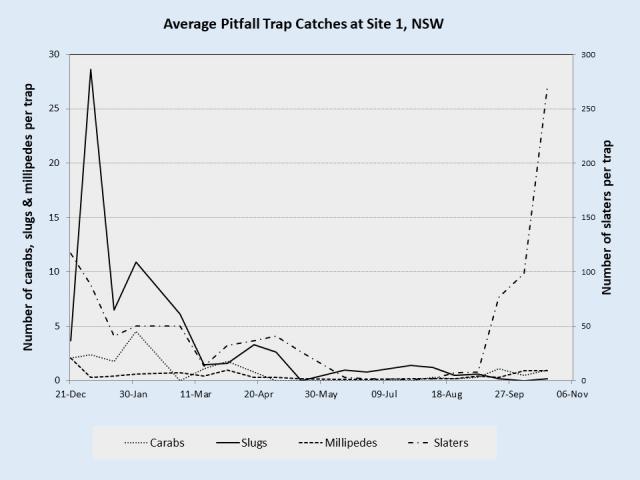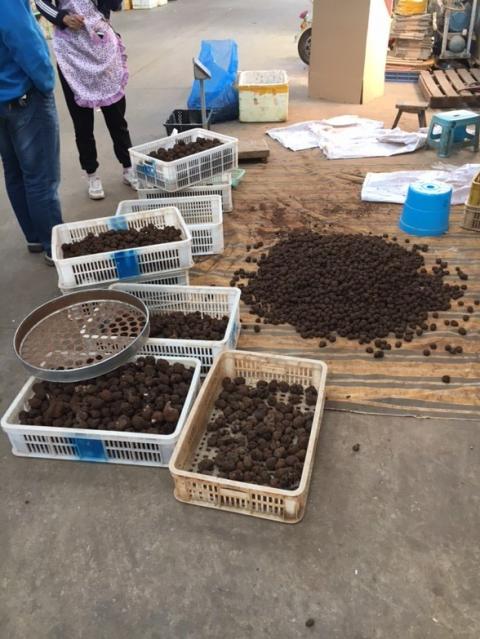DIY orchard pest monitoring
The best way for you to gain an understanding of the type and number of pests in your truffle orchard is to conduct regular monitoring and with information we have placed on the DPIRD website, you have the wherewithal to do this yourself. Our monitoring has shown that pest type, abundance, distribution and seasonality varies from orchard to orchard. By doing your own monitoring you can gain an understanding of what pests may be important and whether control strategies are needed. If so, they can be more targeted to those pests. Monitoring over time also allows you to see any impact of control methods used, while monitoring across the orchards can help identify ‘hot spots’.
Slugs and slaters are the most wide spread and abundant invertebrate pests and they can be monitored easily with simple equipment. You can choose to only record the number of slugs and slaters found or use the more detailed score sheet to record other pests such as millipedes, springtails and earwigs as well as predatory beetles. An Invertebrate field guide is available to help with identification.
What you will need for monitoring and the method are outlined below.
You will need
- Fifty, 20 cm square bathroom tiles. Large orchards would require more tiles to ensure good coverage and to see whether ‘hot spots’ occur.
- Flaky bran (available from a feed merchant or hardware store) and teaspoon.
- Score sheet, use either the slug and slater score sheet or the more detailed version.
- Invertebrate field guide
Method
- Plan the location of tiles so they are evenly spaced across the orchard.
- Place tiles close to a tree – this is where we find slugs and slaters will occur; they are out of the way of orchard operations; and more easily relocated.
- Before placing each tile, clear the ground the tile will sit on to remove leaves, weeds and small pebbles. This makes observing and counting easier.
- Place one heaped teaspoon of flaky bran on the ground and place the tile on top.
- Two days later check under each tile. Record the numbers of invertebrates present.
- We recommend removing bran after monitoring so that slugs and slaters can redistribute as normal so as not to bias future monitoring.
- Lean tile up against the tree until monitoring is repeated.
Repeat monitoring every four weeks or as time permits
For very abundant unidentified fauna, use the MyPest Guide Reporter app, or collect samples and contact one of the DPIRD truffle project team. If you send photos in for identification please ensure they are in focus and close enough to discern features.
This information on pest monitoring, plus links to score sheets and field guide pdf’s and project member contact details are available on the DPIRD website.
Truffle damage assessments in Western Australia - 2017 harvest
Assessments of damage in truffles were undertaken at five Western Australian orchards throughout the 2017 harvest. The assessments looked at the type and level of damage occurring in truffles harvested at different depths.
The assessments were conducted fortnightly. The first 50 truffles harvested for the day were collected and the depth as which they were growing was recorded as either exposed, shallow (top of the truffle up to 25mm below the surface) or deep (top of the truffle over 25mm below the surface). The 50 truffles were then washed, weighed and assessed for damage.
Early on we realised that it was very difficult to differentiate between slug and slater damage so these were combined. Slugs and slaters tend to graze the truffle, to create a chewed surface or cavern. Other distinctive damage caused by invertebrates is pinholes. Pinholes are characteristic of truffle beetle feeding and larger pinholes have also been seen to be created by millipedes.
There was a clear trend between less invertebrate damage with greater depth. Rot was also recorded in these assessments and while the level of rot was generally low, it too had a pattern of less rot on deeper truffle. This backs up the findings of Harry Eslick who looked at truffle rot as part of his PhD. The management implications for this are that growth of deeper truffle should be encouraged.
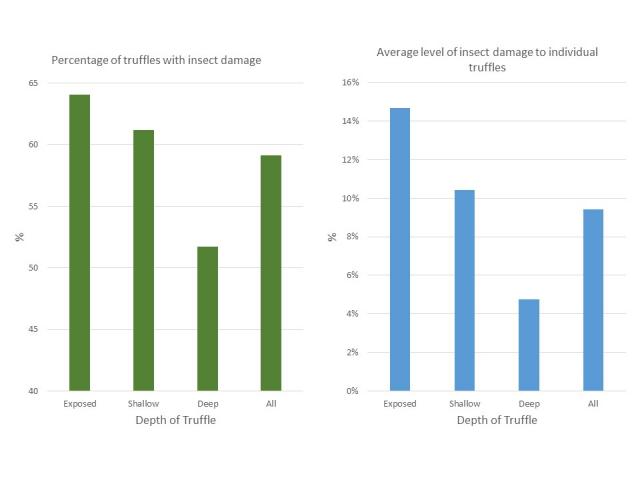
The majority of truffle pests are generalist feeders that will eat truffle if they happen upon them. If the truffles are growing deeper and invertebrates do not have access to them then damage will be less. Although it should be noted that we have found truffles over 50mm below the soil surface with extensive feeding, but this was in orchards where pest pressure was very high. Variations in pest pressure are thought to be a large reason for the variation in damage across orchards that we found.
Orchard monitoring in the east
It’s been a very busy year.
Pest numbers
Pest types and numbers have varied across truffle orchards and across seasons, with some orchards showing high numbers of slugs and millipedes and others showing the occasional explosion of slaters. Observations in eastern Australia combined with those in Western Australia are starting to provide a picture of how the populations vary with season, weather and management.
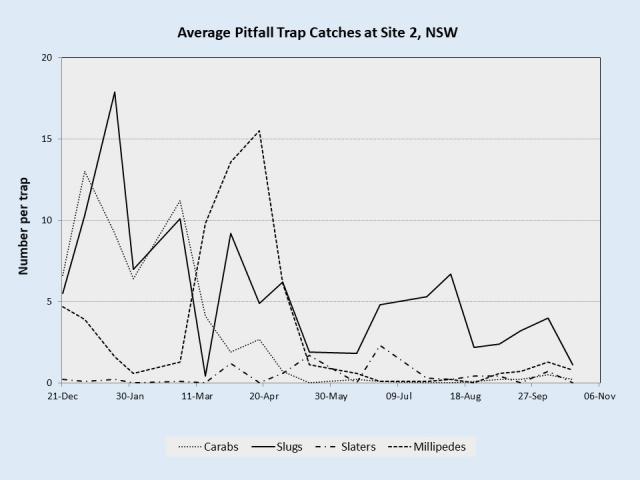
The role of the orchard floor
Observations in eastern Australia have revealed a strong relationship between the amount of orchard ground cover/mulch/trash and the prevalence of pests, especially slugs and slaters. It was both interesting and telling that, as reported at the October national truffle conference, observations and conclusions on orchard floor cleanliness in the west closely matched those in the east: orchard floor hygiene would appear to be important in reducing the pest pressures on damage to truffles.
Truffle damage
In most of the orchards visited and/or studied, pest damage to truffles has noticeably increased this year. A significant increase in “grazing” damage, especially from slugs, slaters and (to a lesser extent) millipedes was reported in most, but not all, truffle orchards visited. Reported rot levels ranged from 5 to 35 percent, but this is just the tip of the iceberg, with an unknown amount of well-rotted truffles left in the ground.
What's next in the east?
Trials will soon begin in the east to look at various pest management scenarios. These trials will match those being conducted in the west, and will hopefully help point the way forward for reducing pest damage to truffles.
Slug and slater field trials
Slugs and slaters top the ‘most wanted’ list of truffle orchard pests, largely due to their wide distribution and, at times, very high numbers. They have been the focus of recent field work.
We assess the abundance of these nocturnal arthropods by placing bathroom tiles on the orchard flor and check them during the day. In order to fine tune monitoring for slugs and slaters we looked at the effect of location of tiles within an orchard – Where did we get optimum pest observations: next to the tree, between trees along the row or in the inter-row? This was conducted in two orchards in WA and two in NSW.

The results showed that in orchards with relatively minimal ground cover the slaters tended to congregate near trees. In orchards with more leaf litter and weeds/grass in the inter-row, slug and slater numbers were generally more evenly distributed, or with higher numbers found in the inter-row. This suggested that monitoring next to trees was the best option. Not only are you most likely to pick up pests with this placement but by placing the tiles next to trees is minimises disruption to orchard operations and makes it easier to mark their location for recovery and ongoing monitoring.
This variation in pest distribution across the orchard floor is not surprising given habitat preference of both slugs and slaters. Both prefer damp, dark places and feed on decaying organic matter. Where the orchard floor is relatively bare the area around tree trunks, particularly hazels with many suckers, is a more attractive habitat.
The next trial looked at the type of attractant placed under the tile. Previously we’d found that flaky bran increased the number of slugs under tiles compared to using no attractant. Alan Davey found that using dog kibble proved very attractive to slaters. We used flaky bran, dog kibble and cracked wheat as attractants under tiles to compare with tiles with no attractant. While overall slater numbers were lower than desirable for such a test there was nothing to suggest the other attractants were any better than flaky bran. Also we found that ants were attracted to the dog kibble. So we’re sticking with using the flaky bran under tiles for now as the recommended monitoring method
For orchardists who would like undertake their own monitoring, see the DIY article in this newsletter.
Current trials are looking at control methods for slugs and slaters. These trials are ongoing and results will be disseminated to growers at a later date.
Using wet traps to attract truffle beetle
Truffle beetle (Thalycrodes mixta, Family Nitidulidae), is still a concern in one WA truffle orchard. As part of the aim to protect truffles from the beetle, we are studying the seasonality of the beetle. An important aspect of this is continuing to fine-tune monitoring techniques. Previously we were using pitfall traps and flight intercept traps and this spring we are assessing wet traps as well.
Wet traps use the same equipment as the pitfall traps that we have described in previous newsletters, the difference being a solid base container is used and 100mL of a 50:50 beer: molasses mix plus one teaspoon of yeast is added. These molasses-yeast traps are used by beetle specialists to capture nitidulid beetles in a variety of environments, and are particularly effective for that family alone (thus excluding the bycatch common in pitfall-based survey methods).
We have installed wet traps in four orchards this spring to compare against standard pitfall traps baited with truffle. Monitoring took place over spring and early summer, the period of peak beetle activity last year. We found truffle beetle only in one orchard this spring/summer, which had confirmed truffle beetles in the 2016 and 2017 seasons. The wet traps are performing well. Beetles were found in wet traps nine weeks earlier than in the dry traps and so far over 98% of truffle beetles collected this spring and summer have been from wet traps.
Trials in Spain looked at using pitfall traps for mass trapping as a control method for the European truffle beetle, Leiodes cinnamomea. Preliminary results found that in orchard sectors with mass trapping there was less damage and less severe damage to the truffles. They recommended installing traps at a density of 30/ha. It is not known if a similar mass trapping control system would work for the Australian truffle beetle. Although, it is good to know that the beer, molasses, yeast combination is more attractive to the beetles. This is encouraging for both improved monitoring and potentially as a means of management by reducing beetle numbers.
Out and about with the project team - Spring extension activities
The project team continues to regularly update the industry on our activities and this spring we’ve presented at the annual Australian Truffle Growers Association (ATGA) conference as well as a Truffle Producers of Western Australia (TPWA) field walk. The Pest and Disease info page on the DPIRD website has also been updated.
ATGA Conference – Ballarat November 13-15
The Truffle Pest and Disease project was well represented at this year’s ATGA conference in Ballarat. Alan Davey, Alison Mathews and Anne Mitchell ran a Pest and Diseases Workshop and Research Communication at Oakhill Truffles on the Friday, with guest presenter Peter Del Santo who discussed some of the principles involved in pest management. With the exception of Peter, each also made a presentation at the more formal part of the conference on Saturday and were available during the Sunday field walks to answer questions and talk to growers.
The Workshop focussed on the main pests of truffles and methods of controlling them. Oakhill Truffles is a monitoring site for the project so we explained the use of pitfall and tiles traps and encouraged growers to undertake monitoring on their own properties. An information pack on this is available on the DPIRD website.
Alan Davey and Alison Mathews both gave presentations on the field and lab work that has been taking place this year, with perspectives from eastern and Western Australia. Results were similar with slugs and slaters being the most widespread and prolific pests. The indications are by making the truffle orchard habitat less suitable for these pests, their numbers will reduce, resulting in less damage to truffles. Growers were encouraged to undertake their own monitoring as we have found that while there are trends across many of our monitoring sites, each orchard has its own peculiarities in terms of the type, number and seasonality of its pests.
Anne Mitchell spoke on the results of part of the national truffle grower questionnaire survey that was undertaken in 2015/16. There were 118 respondents across Australia, covering some 200,000 trees. An analysis of planting dates showed that while there has been continuous planting since 1997, there is a peak of planting from 2009 to 2012. This indicates that production will continue to increase for the foreseeable future. The vast majority of growers have planted trees inoculated with Tuber melanosporum, with smaller numbers of growers planting trees inoculated with T. borchii, T. aestivum and/or T. magnatum. Loam and loamy soils were the main soil types identified in truffle orchards with sand being the next most common. Irrigation was highly variable with some growers irrigating daily while others irrigate fortnightly.
Reports of pests and diseases were summarised, along with observed damage. Orchard floor management appears to be an important strategy in reducing truffle pest numbers. Less than half of growers actively manage the leaf litter. The role of cultivation of the orchard floor in production of truffles, or weed management is the subject of much research, both here in Australia and in Europe. Less than half of the responding truffle growers reported cultivating. Management of shallow or exposed truffles has been shown to reduce the incidence of truffle damage, specifically truffle rot. Two thirds of responding growers indicated some covering of exposed or shallow truffles.
Further analysis of the surveys is underway and will be reported in 2018.
TPWA Field Walk – 28th October 2017
For WA growers unable to make it to the Ballarat conference, Alison Mathews gave a similar presentation to the one she gave in Ballarat. Wintery weather turned the field walk into a shed talk but this didn’t dampen the discussion. Alison’s talk discussed results of the recent slug and slater field trials and truffle damage data from the 2017 harvest in Western Australia.
China Conference
Anne Mitchell was invited to present at the 5th International Truffle Festival and Congress held in Nujiang, Yunnan Province 6-9 November 2017. This was a fantastic opportunity to hear about truffle research that is taking place globally and meet the people involved.
Some key points from the conference were:
- The Chinese scientific community are very active in truffle research and actively collaborating with truffle scientists around the globe, including France, the US, Spain, Taiwan and Mexico.
- The Chinese have a developing interest in their native truffles both black and white. Many of those truffles have traditionally been used for medicinal or health purposes.
- Historically truffles have been harvested by raking but this practice is now being discouraged in favour of using dogs.
- There are at least 50 species of native Chinese truffle that are being investigated. Recently some of these are being used in truffle orchards, particularly Tuber indicum.
- Truffle scientists are just beginning to address the issue of pests in truffles. They were keen to understand the role of pest management in establishing orchards.
- While they have been researching inoculation techniques since the 1980’s, their current production is largely based on truffle from native forests. Reports of Chinese truffle entering the European market range from 30 to 200 tonnes per year.
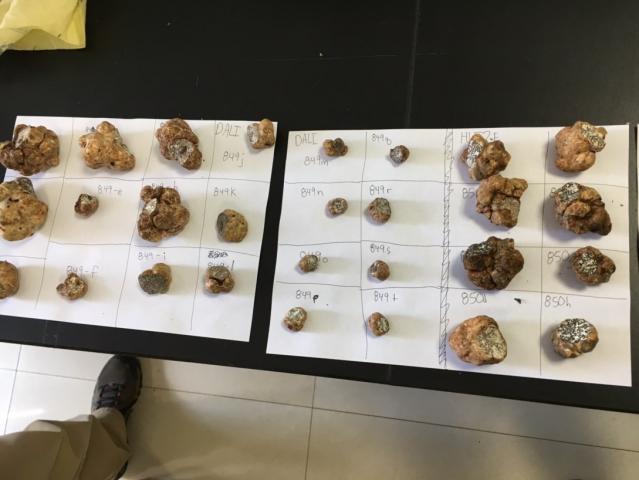
Pest and Disease Info Page Update
During 2017, we learned that truffles may be damaged by a range of pests not previously thought to be important. These and other changes have been included in an updated version of the bulletin on Pests and Diseases of Truffles and their Host Trees on the DPIRD web page.
As mentioned in other sections of the Newsletter, we have also added a note on ‘do it yourself’ truffle pest monitoring, with an emphasis on the main truffle pests – slugs and slaters.

